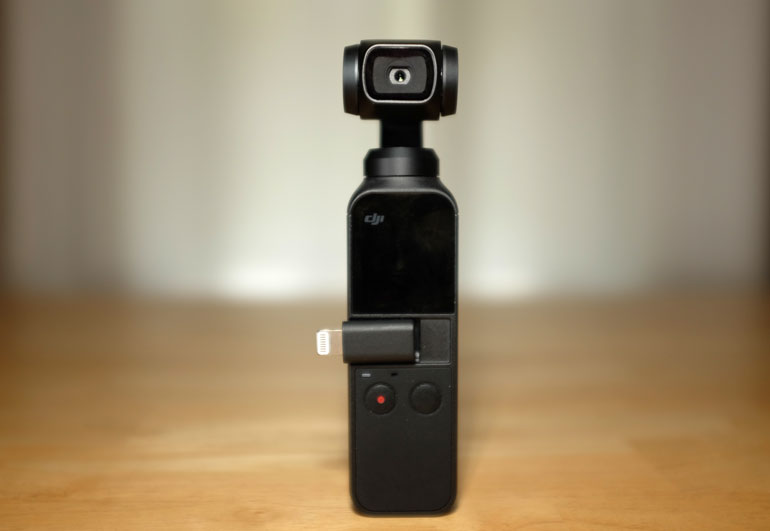DJI Osmo Pocket
You’ve got to hand it to DJI. Time and time again, they find a way to get people excited to spend their money on new tech that is cool but nonessential. The DJI Osmo Pocket is exactly that: an amazing tiny little camera that we all want but don’t really need.
And it’s priced low enough that we’ll all probably buy it anyway, even if we don’t have a clear use for it.
As the saying goes, the best camera is the one you have with you. That used to mean something different. A few years ago, most people rarely carried a camera around with them. It would be a feat of luck to capture something fleeting while also holding a professional camera.
But now nearly everyone on the planet has a phone in their pocket. Today we rarely, if ever, think to ourselves, “Dang, I wish I had my camera to capture that.” Someone always does.

The DJI Osmo Pocket aims to replace that camera you always have on you, literally in your pocket. It’s also the world’s smallest 3-axis gimbal stabilized video camera.
That’s all pretty impressive, considering the first 3-axis gimbals hit the market only about 5 years ago, and it cost $15,000 and required two people to operate. And that was the gimbal alone, not including the camera.
But by now, most professional video producers have gimbals, and we all have smartphones, and we probably have B or C knockaround cameras. And yet, DJI has given us a highly desirable new thing that doesn’t really do anything new.
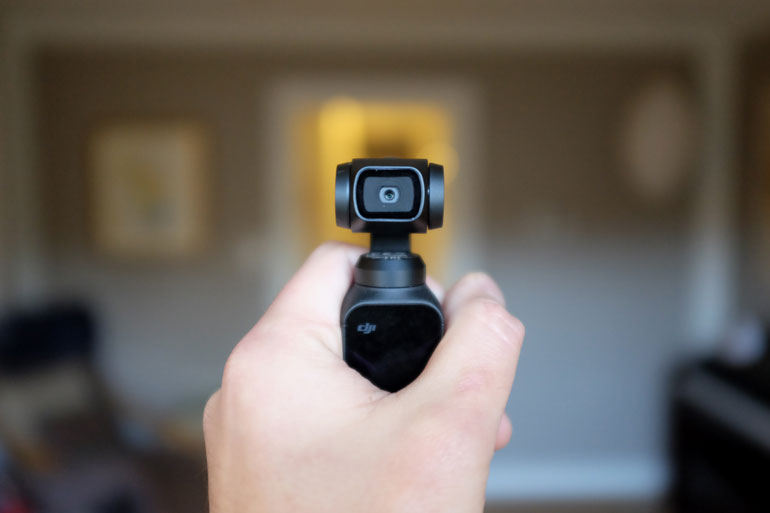
Again, you’ve got to hand it to DJI. Even when we think we have a drone that is amazing, like the Mavic Pro, they come out with a new Mavic that makes us whip out our credit cards without question. Just like how they recently came out with a gimbal - the Ronin-S - which we all got jazzed about, even though we already have working gimbals at our disposal.
So the question is, is the Osmo Pocket just another fun toy that we want but don’t really need? Or does it add something to our suite of tools that enables us to make films better, or different, or just more convenient?
DJI Osmo Pocket Specs Overview
We’ve used the Osmo Pocket for two months now, and we’ll go into details about our views on its capabilities below. But first, here’s some of the spec highlights.
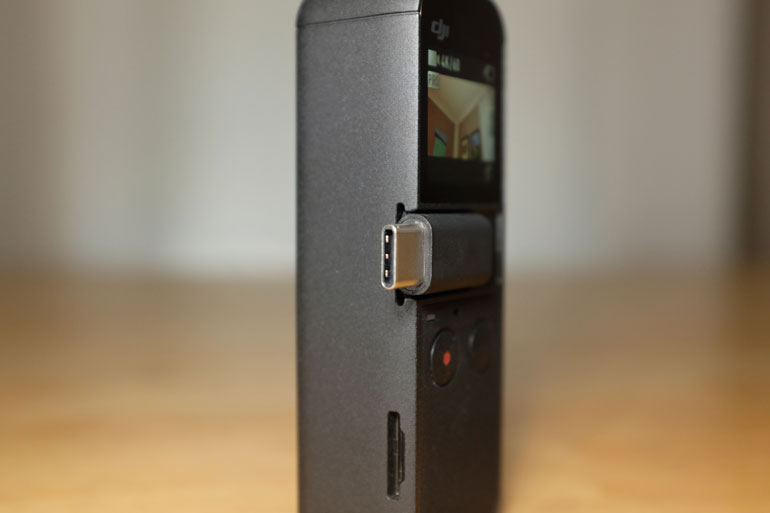
- It weighs about four ounces, and is less than 5 inches tall. Essentially it’s about the size and weight of a candy bar.
- It has a 1/2.3-inch CMOS sensor, and a wide f/2.0 lens with an 80 degree field of view. It’s reportedly the same camera as the Mavic 2 Zoom.
- You can shoot UHD 4k at 60 frames per second, HD at 23.976 fps and slow-mo at 120fps, and a few variations in between. Bitrate goes up to 100 Mb/s. That gives you up to 140 minutes of 1080p video.
- It accepts up to a 256gb microSD card, but if there’s no card in the slot, it will record to your smartphone.
- There’s built-in autofocus with active tracking of objects and FaceTrack for faces. And it’s actually pretty good.
- The postage stamp sized display is touch-screen that allows you to select what’s in focus.
- With the free DJI Mimo app, you can connect an iPhone or Android smartphone or device directly to the Osmo Pocket to enable a bigger viewfinder, more advanced features, and playback. Amazingly, the app opens up automatically when you connect your device to the Pocket.
- The Pocket can easily switch from outward mode to selfie mode, and with the built-in microphones, you can use it as a fully-fledged vlogging camera.
- The internal battery lasts up to 2 hours recording at 4k/60, and longer with lower resolutions. You can connect an external battery to the USB-C terminal and charge and record simultaneously.
- The Osmo Pocket can also record photos up to 12 MP, which is really useful in the timelapse or motionlapse modes.
- The gimbal can be set to 3-axis follow mode, or FPV mode, or you can lock the tilt and capture very stable video or photos for a hyperlapse.
- There is a complete automatic exposure mode that makes it just about the easiest video camera in the world to use (literally just one button to power on, and another to record). There’s also an Auto ISO mode that keeps shutter speed / angle static.
- Added video features such as ant-flicker, an on-screen grid, a histogram, noise reduction, adjustable mic levels, a zebra for overexposed areas, and multiple focus modes.
- As with all DJI products, there’s a whole suite of features like NightShot, panoramic effects, and motion control that are neat but you probably won’t use.
- Like the DJI Ronin-S, the company has opted to launch the Osmo Pocket first, before adding additional accessories and features later. There are also third-party accessories that have quickly arrived on the market.
Professional Use case
Many working videographers are snapping up the Osmo Pocket because it’s cheap enough to have around, just in case.
It’s the same reason why pro shooters give themselves a reason to buy a camcorder like the Canon XA11, or fixed lens cameras like the Canon XC10 and XC15. You can hand it to someone to shoot BTS or an additional angle, and it’s easy enough for a newbie to use. Or in a pinch, you can use it yourself for steady and smooth walking shots, or footage inside a car or another moving vehicle.
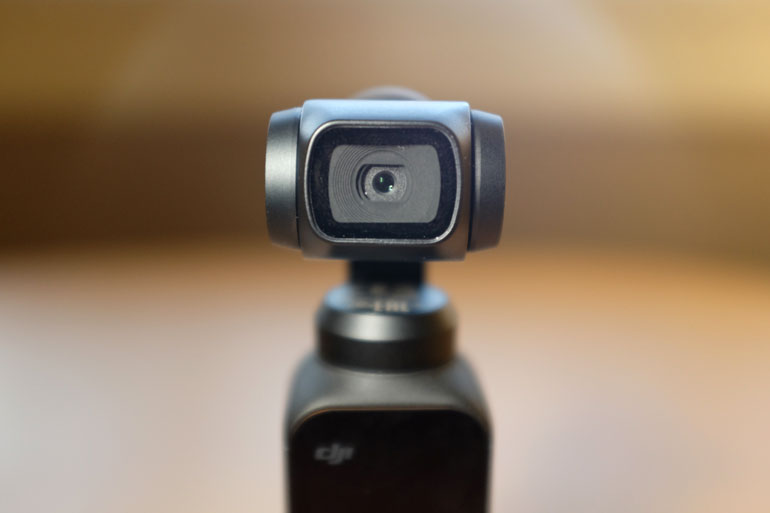
The truth is, the DJI Osmo Pocket does not make pretty pictures or video. At least not yet, until there’s a firmware update that adds a Cine-Like flat picture profile. Right now, the Pocket takes standard everything-in-focus video with low dynamic range and a high contrast.
Yes, it shoots 4K at 60fps. But so does your smartphone. And if you’re ever on a shoot where something is happening suddenly and you don’t have time to use your A-cam or your DSLR or mirrorless B-cam, you could certainly be up and running with the Osmo Pocket quickly.
But in those situations, the quality of the video doesn’t matter as much as simply capturing the fleeting footage. And to be honest, you or someone else is much more likely to whip out a smartphone to capture those moments.
Non-Professional Use Cases
If pro videographers aren’t going to replace their main gimbal rigs with the Pocket, then who is going to use it?
Well, the thirst for video has exploded in recent years, and now pretty much every corporate office, small business, educational institution, or nonprofit wants to share videos regularly on their feed.
They don’t care about the best video quality, or storytelling, or any of the things that make video production an expensive but valuable part of digital marketing. These people want video and they want lots of it, without a thought to the who, what, where, why or how.
These are the same people who relentlessly go on at meetings and parties about how smartphones can now shoot 4k video, quality that is better than cameras a few years ago. As if pixel resolution was the only thing that signaled quality video storytelling.
The truth is, these guys have every right to be excited about the DJI Osmo Pocket. With only a power and record button, this is certainly the tool that will enable a ton of simple and easy video productions that can go quickly to social media, without complicated gear setups.

With our Osmo Pocket, we recently shot a series of videos using the Pocket for our local university, where the camera focused on an Apple Watch before moving quickly (in a hyperlapse-type shot) through campus. It only takes this amount of minutes or seconds to get to this place.
It’s a simple brief that would have taken a lot of work to rig up a cinema or DSLR camera on a gimbal, hold up for half a day, and hope that everything works out.
With the Osmo Pocket, we were able to get 6 videos done within a couple hours. The auto exposure meant we didn’t need to worry about changing light conditions. The touch screen focus enabled us to move from exteriors to a macro focus on an Apple Watch. And the tilt lock got us hyperlapse-style footage that was nearly as good a real hyperlapse, without the pain of shooting a real hyperlapse.
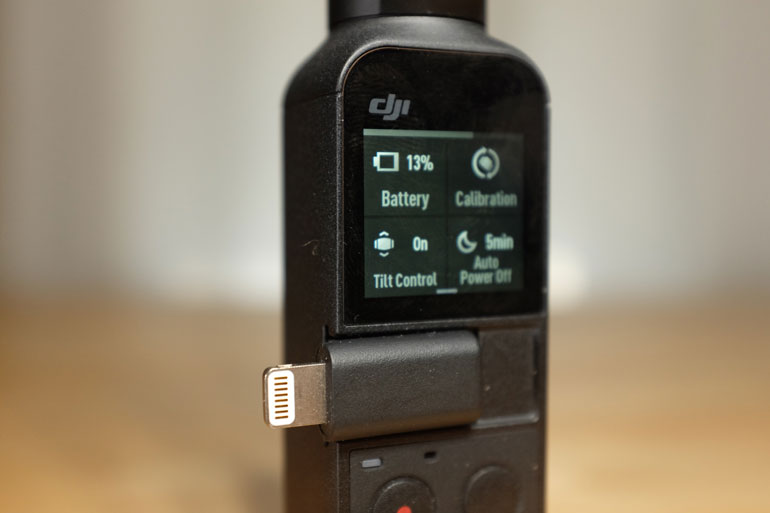
There are many other use cases for the Osmo Pocket in this case, where you can easily hold it for a long time, set it on a table, shoot some walking shots, and get something out to social media without a lot of hubbub.
So in our opinion, the DJI Osmo Pocket solves an essential need for companies and organizations who want to shoot simple video, without getting professional videographers or complicated gear involved.
But doesn’t this describe smartphone video?
DJI Osmo Pocket vs Smartphones
The main competitor to the DJI Osmo Pocket is the average smartphone you already have. It can do nearly everything the Pocket can do, and is just as easy to use, except without the 3-axis gimbal.
But while the entire planet is rambling on about how the smartphone can shoot video brilliantly, we wonder, have people actually tried to shoot video on their smartphones?
For one, smartphones are becoming very delicate and difficult to hold. You are very likely to drop it while trying to shoot a vlog or a social media video. That’s a huge risk considering iPhones are now costing over $1000.
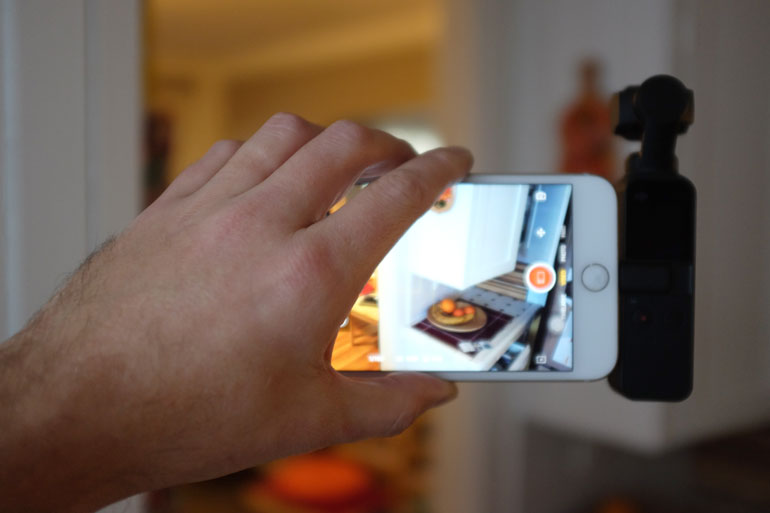
Two, many people still don’t know how to shoot smartphone videos in any way outside of their default app. Which means they don’t have any control over resolution, white balance, exposure, focus, or audio.
Most importantly, we just don’t think people are willing to give up their phones to shoot a video that’s anything but a personal vlog or travel video. As soon as you hand over your iPhone to a camera operator on a corporate shoot, you don’t have access to your it for the hour or two that they’re shooting.
And if you’re shooting yourself, how often do you get notifications, text messages, battery warnings, and so on that get in the way of trying to shoot a little video.
It’s kind of like the original argument for the iPod, when the iPhone began doubling as a music player. People were up in arms, questioning why would they run down their important iPhone battery on a trip, just to listen to music.
When you use your iPhone for video now, you are essentially trading all of your connected life for a few hours, just because your phone has a good-enough camera in it.

A little peak into a Digital Filmmaker gear shoot
The DJI Osmo Pocket solves that by being a completely separate object. You can hand it to anyone in your organization to shoot video, throughout the day, without sacrificing your phone. You don’t have to figure out how to get footage from a colleague’s device to your computer.
Mostly, you can just set it to automatic-everything-mode and any monkey can figure out how to use the Osmo. Because believe it or not, most people do not know how to use their phones for advanced video shooting. With the Osmo, it’s literally just one button to turn it on, and another to start recording.
And you can hold the Osmo Pocket outside a car window, without fear of dropping your $1000 iPhone XS.
Auto Exposure - So Easy A…
As mentioned above, the biggest selling point of the DJI Osmo Pocket for us is that it truly is the easiest video camera in the world to operate. Easier than any smartphone. Easier than a consumer camcorder.
When you setup the Pocket in the Mimo app, you can change the Pocket’s exposure to fully automatic. That, plus the white balance and focus can be set to automatic as well. After that, you have a camera that you can realistically hand to someone who is a tech dummy, and they’ll provide you usable video.
In auto-everything mode, it only takes one button to power the Pocket up, and one button to record. A triple click on the power button switches the camera from forward-facing to selfie mode, which automatically actives the FaceTrack feature. It couldn’t get any simpler.

But of course, someone will always accidentally find a way out of the auto setting. They’ll either click on a few too many buttons, or they’ll accidentally navigate to the menu, or they’ll move the camera too fast and the gimbal will get into some weird position. And they won’t know how to re-center it.
So you can’t assume it’ll be a fool proof, newb-proof video camera. But it’s certainly close. It’s too bad you can’t hit a “newbie lock” button of some sort, to prevent any additional changes from being made.
Shutter Priority Auto Exposure
In full automatic exposure mode, both the ISO and shutter speed will shift to compensate for exposure. That’s probably ok if you don’t care about the video quality a lot, and just need it to work for anybody, anywhere.
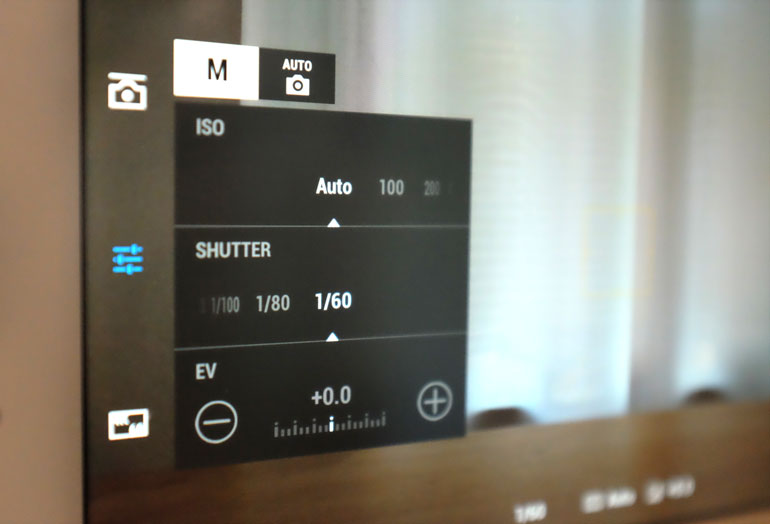
But if you’re operating the camera and you know what you’re doing, you might as well set the Shutter Speed to your 180 degree angle (or thereabouts), and then the Pocket will only adjust ISO automatically.
Keep in mind, you’ll probably need ND filters if you’re shooting in auto exposure mode outdoors, but that’s only if you care about the video quality all that much. Which, at the moment, if we’re using a Pocket, we kind of do and kind of don’t, right?
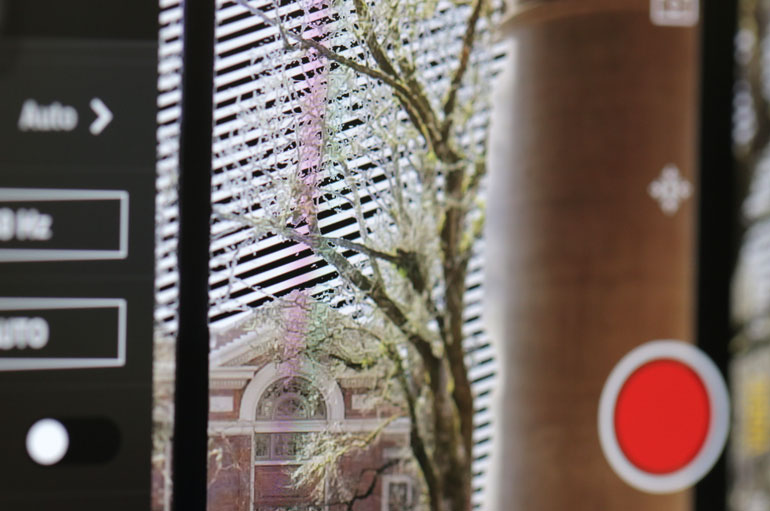
Overexposed zebras are a nice feature for pro users, but who's using this for pro video?
Osmo Pocket Autofocus
The other automatic part of the Osmo Pocket is not nearly as fool-proof. The automatic focus on the Pocket has already gathered a lot of hate in online forums and videos.
There are two forms of autofocus - AFC or Autofocus Continuous, and AFS or Autofocus Single. In AFC, the Pocket is continually hunting to find focus.
One problem is that it hunts and re-hunts, and you can see that in your videos. Even if you don’t change anything in your frame, the Osmo Pocket will repeatedly do a quick focus check, which becomes noticeable.
For us, the bigger problem is that in some situations we couldn’t get it to hold focus in AFC at all. At first we thought it was a cold weather thing - we were shooting in the low 30s in December. But then we ran into the same issues in warmer temperatures.
Essentially, for our “hyperlapse” video we mentioned above, we would bring our wrist up into the frame, tap on the Pocket screen to focus on the Apple Watch, which was a little over a foot away from the Osmo.
Once the Pocket locked focus on the watch, it almost got “stuck” in searching for only close objects to focus on. We would remove the wrist from the frame, and then walk around for up to 10 minutes, continuing to try to get the Pocket to focus on simple faraway objects in front of it, like buildings or roadways, but no matter what it would go blurry and again look for something up close, like the watch.
Given that experience, switching to AFS mode seemed a lot more dependable when we were shooting a deliberate scene. But when handing the Pocket to a newbie, you would want to leave it in AFC mode, and we’re a little concerned that we’ll see a lot of super blurry footage this year. Let's hope a firmware update fixes this major bug.
Narrow Field of View
Apart from the buggy autofocus, our initial major complaint was the tiny built-in screen. Yes, it’s incredibly small, about the size of a postage stamp. But the worst part is the 4:3 aspect ratio, which means you can’t see what you’re actually shooting in video mode.
There’s shooting semi-blind with small screens, like how we’re all accustomed to shooting with our DSLR and mirrorless little displays, and for the most part we’ve learned to trust the camera rather than our eyes. But in the case of the Osmo Pocket, this is shooting full-on blind.
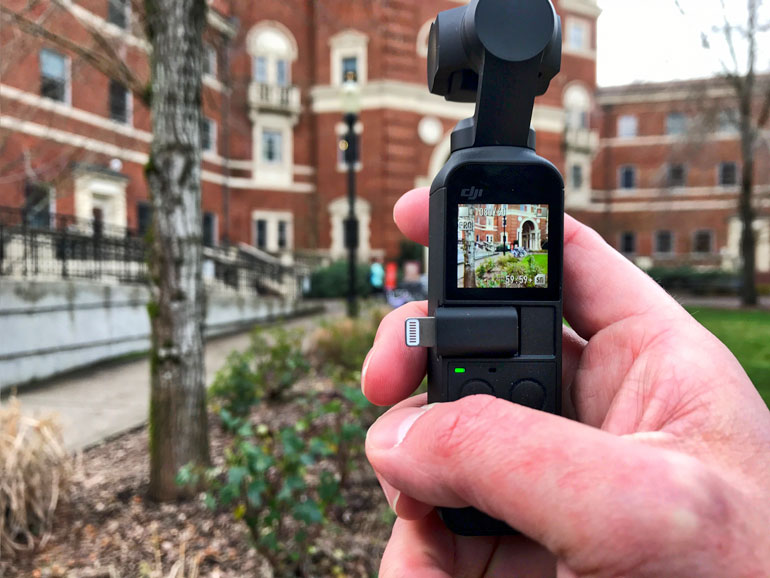
It wouldn’t be an issue if the Osmo Pocket had a super wide angle lens, like a GoPro Hero. But the Osmo Pocket has an 80-degree FOV, which makes it actually pretty narrow when you’re shooting close to your subject.

Turns out if you use this camera to film your family or friends, or yourself in selfie mode, you’re almost always too close to them. Trying to keep people in the frame becomes a huge pain. And trying to figure out whether they’re staying in the frame with the 4:3 thumbnail image on the display, means you’re never really sure.
Thankfully, you can go into the settings menu and switch the display to show the full widescreen 16:9 image. The video settings and media information will appear in the black space above and below the image, which is nice so that it doesn’t cover up the already small view of what you’re shooting.

We mention this because the display setting may not be immediately obvious to a new user. And it could turn the first few shoots into a frustrating nightmare.
As for the lens field of view, unfortunately there’s no setting to turn the FOV into a wider lens. That would be really nice, especially if DJI expects the Osmo Pocket to actually be adopted by vloggers.
At the moment, DJI wants vloggers and selfie shooters to buy the selfie stick accessory to get a wider shot. Which is a nice accessory, but makes the Osmo Pocket a lot less attractive as the world’s simplest video camera you always have on you.
DJI Osmo Pocket Accessories
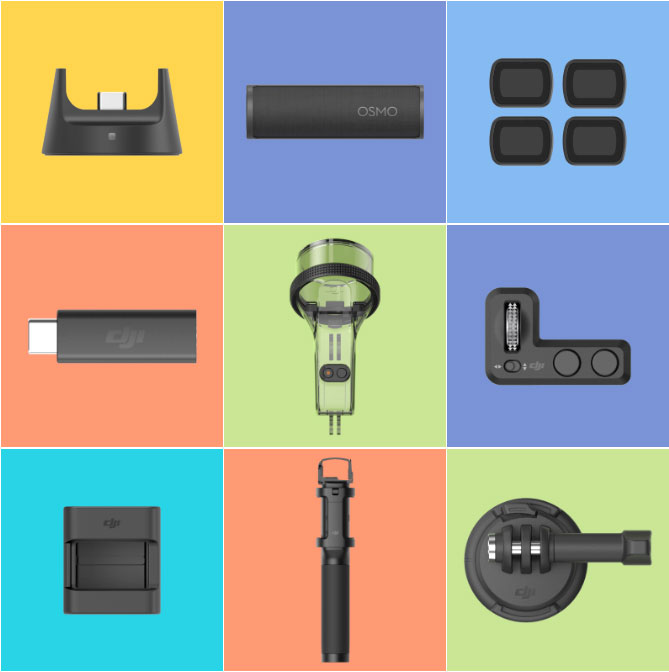
Like the Ronin-S gimbal, DJI has created a little ecosystem of tech accessories for the Osmo Pocket, some of which are being rolled out slowly. And amazingly, there is already a growing marketplace of third-party accessories that has sprouted up, to give Pocket users more options or toys to play with.
Tripod Mount
Probably the first accessory you’ll want is a little tripod adapter. Unfortunately, the bottom of the Osmo Pocket doesn’t have any ¼-20 thread next to the USB-C input. Major bummer.

So you’ll have to either buy DJI’s selfie stick accessory, or its wireless module, which enables it to sit on a table, or you can do a quick search for one of the many 3D printed tripod mounts out there, made by independent sellers.
There are hundreds if not thousands of products and Youtube how-to's already about Osmo Pocket tripod mounts, but one of the most clever solutions we've found is in this video by Markus Fuller.
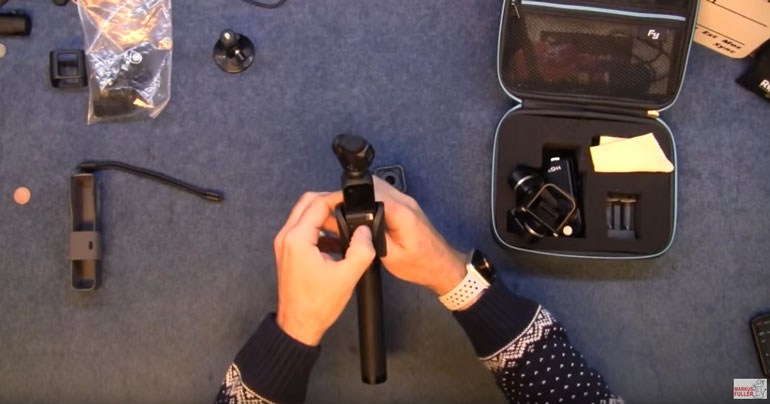
Markus uses a Sennheiser microphone adapter/clamp/holder, which is wider than most other mic holders, and it's the perfect fit for the Pocket to slide in. Then you just need an adapter to turn the ⅝-inch microphone stand thread into a ¼-20. It also works for attaching to a selfie stick or pole. We're not sure of the mic holder model number yet but we're working on it.
Smartphone Holder

If you plan to primarily use the Osmo Pocket with a smartphone, you’ll probably want something that makes the connection more rigid, like the PGYTech phone holder.
Otherwise, the only thing holding your phone to the camera is the Lightning or USB-C connection.
This is also recommended because you don’t want to put that much pressure on your phone’s primary connection point for charging and phone accessories.
Over time, something may wear out, and while a replacement Osmo Pocket phone connector is cheap, a new phone is not.
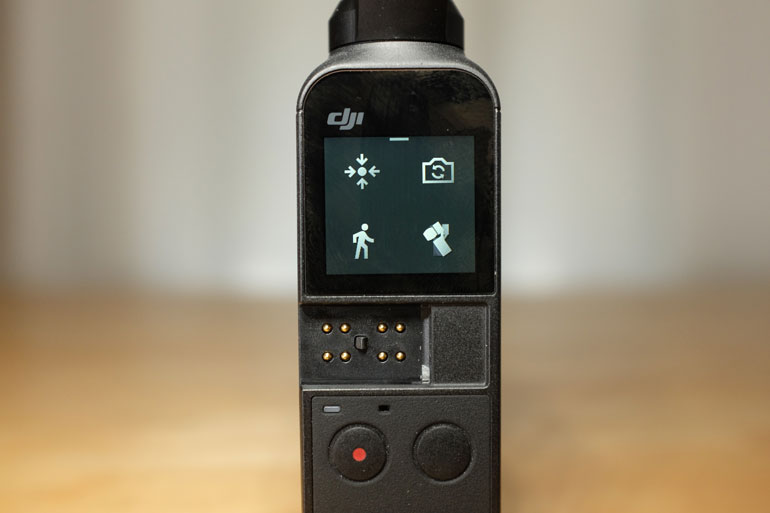
DJI extension rod / Selfie Stick
In addition to providing a much needed tripod mount, the extension rod is a telescopic selfie stick that makes shooting wide-angle selfie videos a much easier task with the camera’s narrow field of view.
It also has buttons that enable you to control the camera and gimbal, which is a nice touch. Here's a pic of what the selfie stick looks like when used by a cyborg.
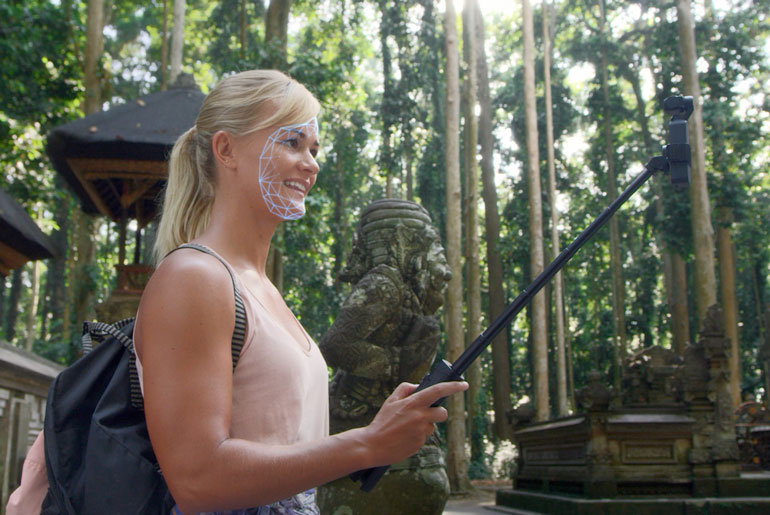
Wireless Module

This accessory might give your Osmo Pocket a whole new lease on types of shooting scenarios. The DJI wireless module enables you to control the camera via Bluetooth and Wifi, with your phone or device.
In addition to giving you a remote control for rigging the Pocket in hard-to-reach areas, the module also has a flat base that makes it easy to stand on a table without a tripod.
Unfortunately it doesn’t look like the wireless module grasps or holds the Pocket in any way except via the USB-C connector. So you probably won’t be able to set it up in a tree or hanging off the side of a car.
Cable Extension
Instead of getting the wireless module, you could also find a longer cable that lets you keep your phone a few feet away from the Pocket. There’s a USB-C extension cable that connects to the bottom of the camera, or you could try a Lightning cable extender. These are no-name brands so there's no telling how dependable the cables will be over time.
Controller Wheel
Fitting neatly onto the Pocket, DJI’s controller wheel gives you better control of the gimbal’s pan and tilt. This makes it easier to shoot handheld than using the tilt button on either the Pocket’s tiny screen or on your smartphone.
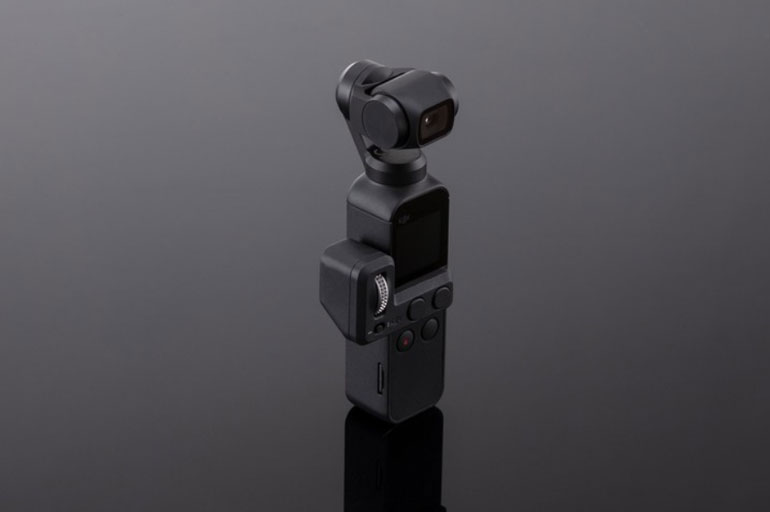
ND Filters
Just like with DJI’s drones, an ND filter is an absolute must if you plan to shoot outdoors and want to maintain an appropriate shutter angle for motion blur.
Currently, Freewell makes a few different sets of ND/PL filters for the Osmo Pocket.

Audio Adapters and Other Accessories
Other accessories include a 3.5mm adapter that lets you plug in an external microphone, a quick-release base for use in an action cam environment, a waterproof case for underwater footage, and accessory mount to fit sports stuff, and a charging case.
For us, a USB-C to 3.5mm adapter is pretty essential if you plan to use the Pocket for a vlog and want to attach either a lav mic or rig up an on-camera Rode mic.
Unfortunately there’s not a better solution for attaching a microphone at this moment. But we’re sure DJI will figure out a way to do it elegantly in the future, either with an accessory or in the next iteration of the Osmo Pocket.
DJI Osmo Pocket as Safe Aerial Camera
One of the first use cases we imagined for the Osmo Pocket was as a replacement for drones when it was unsafe to fly, such as indoors or above people.
At only a few ounces, you could attach the Pocket to any number of monopods, boom poles, rods, broom sticks, you name it. With the gimbal in tilt-lock mode, you can even simulate a jib shot, so the camera remains fixed on an object as you move the pole from the ground to high above.

The now-discontinued Charter’s Pole was actually created for this very purpose, only it was for an older version of the DJI Osmo.
For a while, we searched for a tripod mount that seemed the most solid bet for attaching to a boom pole or monopod. But in the end, we found the cheapest and simplest solution was simply a rubber band. And it feels actually more solid than relying on a little ¼-20 thread.
You could get an extension cable to be able to see what you’re shooting from your phone, and even control the camera and gimbal. But the cables don’t get very long. And to be honest, we’re fine with a little blind shooting occasionally.
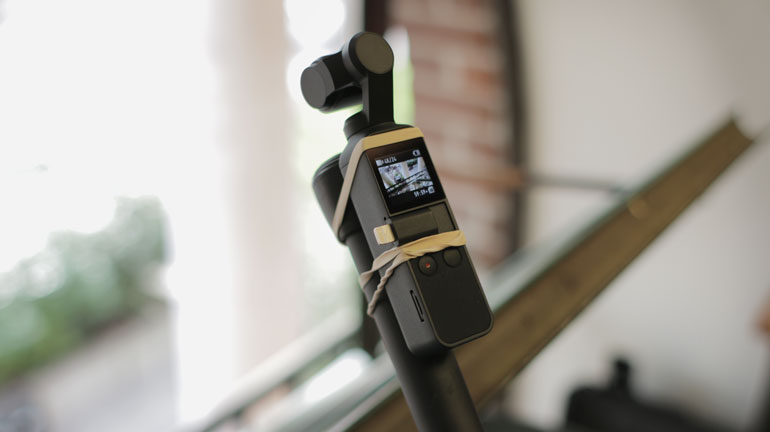
Remember the DJI Phantom 1 and 2? They were used by a lot of people, on many professional shoots, and until FPV monitors came out, we flew them blind. We would fly for 15 minutes in the air, do all these cool moves, and then bring it back and see if what we got was any good. Ah, those were the days.
Well now you can just bring the boom pole back for a quick second to see if what you got was any good with the Osmo Pocket. So, for our buck, rubber band and no extension cable is perfectly fine to use this little candybar camera as a drone replacement when you can’t fly a real Mavic.
Timelapse and Hyperlapse / Panorama
The DJI Osmo Pocket can also take photos. Are you going to use it to take photos? Probably not. But if you’re shooting a timelapse or motion lapse, then it becomes a lot more useful.

There are some easy to understand options for creating a timelapse in the built-in menu or in the Mimo app, and it saves you the hassle of putting together the timelapse sequence in post. You can also set the Pocket to pan while shooting a timelapse.
We think the motion lapse / hyperlapse feature is actually quite useful, because the gimbal can maintain its horizon level as you’re moving. If you set the gimbal to tilt-lock mode, you can actually get a decent motion lapse.
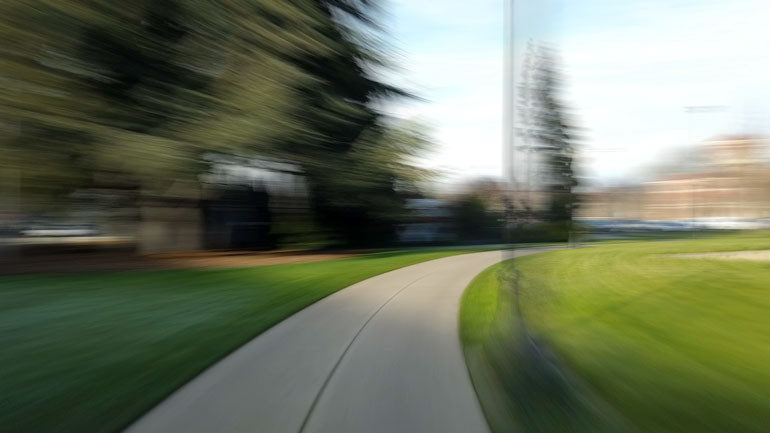
The only thing to be aware of is as you’re holding the Pocket while you’re moving, you will inadvertently take pictures from a different height as your hand moves. That’s why the good hyperlapses are done methodically on a tripod, although that can be a little time consuming and challenging for most people.
If you set your shutter low for a longer exposure, you can even get pretty good motion blur for your motion lapse. Alternatively, we like to use a variety of free motion blur plugins for FCPX. Here's one we like, and also this one.
Actually, we still like to use GoPro's now discontinued GoPro Studio app for adding motion blur to sped up timelapses / hyper lapses. It has a look to it that none of the plugins come close to achieving.
4k at 60 FPS / Video Bitrates / Superfine Mode
It is certainly amazing that this little candybar can shoot 4k at 60 fps, considering there are many professional cameras that still can’t do that. We like it because it gives us more wiggle room in post.
But to be honest, we’re not really interested in analyzing pixels on the Osmo Pocket, whether it’s the resolution, or the various bitrates, or the fine vs superfine comparisons. The footage from this camera is sharp enough, and unless you’re shooting an object up close, nearly everything will be in focus.
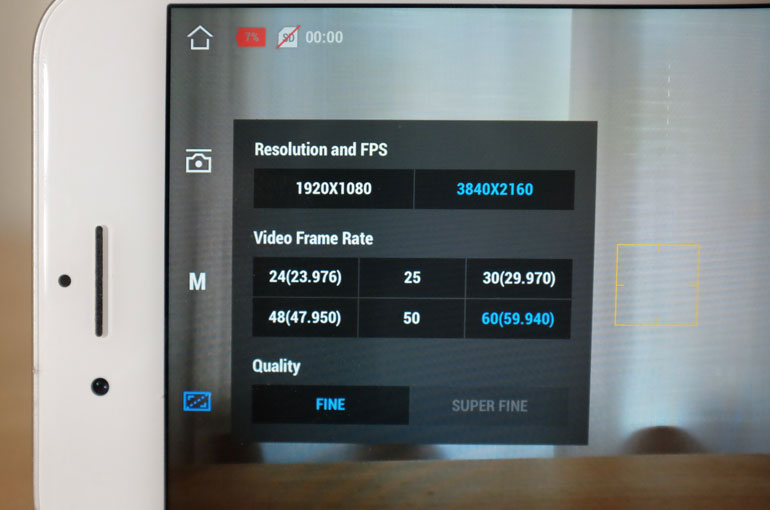
But you’re not getting amazing images out of the Pocket. That’s not the point of this camera. So we don’t see the use in analyzing its so-so footage in micro detail.
What you should know is that superfine mode is limited and is also reported to cause some overheating. Other than that, 4k at 60 is a nice default because it gives you the ability to reframe and also slow down your footage in a 24 or 30 fps timeline.
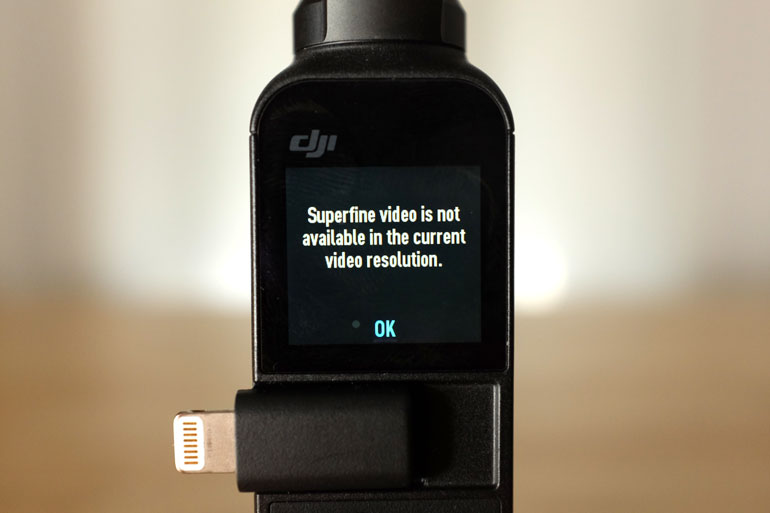
You can also shoot in the dedicated slow motion mode, which creates a 120fps video in 1080p resolution, with a cropped image and low bitrate. For our buck, we prefer to stick with shooting in 60fps and slowing that footage down when we want it.
As for bitrate, it’s important to remember that on a drone that’s shooting distant objects, bitrate becomes a significant spec that can mean the difference between mushy trees and a beautiful landscape. But when you’re shooting with a knockaround camera on ground-level, bitrate is not as essential as basic framing, lighting, and camera movement.
Dynamic Range / Cinelike-D Picture Profile
The other spec that people love to look at is dynamic range. Again, with the DJI Osmo Pocket, you’re not getting a beautiful image. The dynamic range is low, especially in outdoor environments where you have shaded areas next to bright sunny areas. Or indoors near windows.
Part of the issue is the default picture profile is very baked in, which doesn’t give you much of an image to work with. DJI plans to include Cinelike-D in a future firmware update, but at the time of this review we didn’t have that option. When it’s there, we’ll shoot full-time in that profile, because anything is better than the baked in default preset.
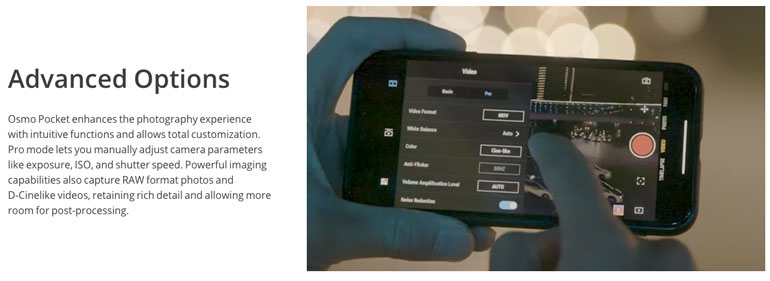
Cine-Like Picture Profile on DJI's Osmo site
DJI Mimo App
The essential app companion to the Osmo Pocket is the DJI Mimo app. And from what we’ve found, it’s also the only way you can unlock Pro Mode, which lets you shoot in 24fps, among other image options.
One of its best features is that when you plug your smartphone into the Pocket, the Mimo app will automatically open (if your device is on and unlocked). That makes using the app incredibly simple, so you don’t have to hunt for it among all your apps.
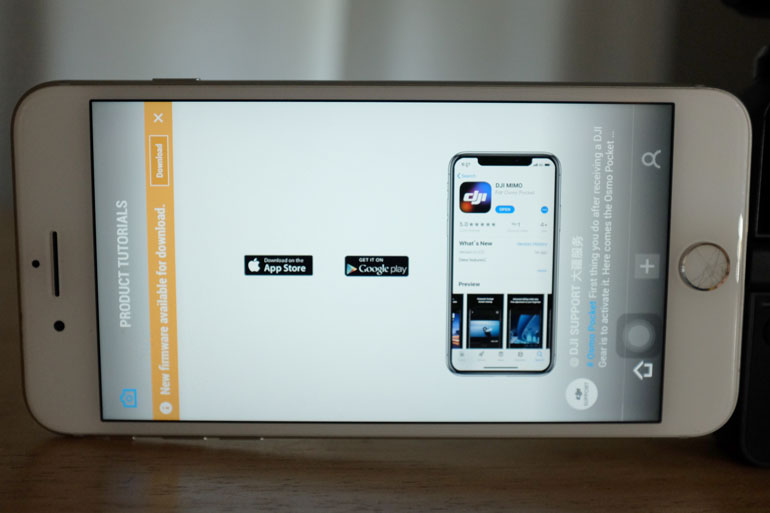
On the downside, a random annoyance of the app is the auto-playing introduction video that has mysteriously started to play in our pockets, even with the Osmo Pocket disconnected. Just to be safe, you may want to mute your phone when you’re shooting in a quiet environment.
What we really like about the Mimo app is if you forgot to insert a microSD card into the Pocket, you can still record photos or video to your smartphone. And later, you can sync that media. That’s a huge win for us, considering there is always a time where you forget you left the media card in the card reader.

Firmware update
Within the Mimo app, you’ll also be instructed to update the Osmo firmware. That’s after you create a DJI login. Initially when we received our unit, we refrained from updating the firmware because we had already booked jobs that were going to depend on the Pocket. And there have been reports of firmware updates bricking the camera.
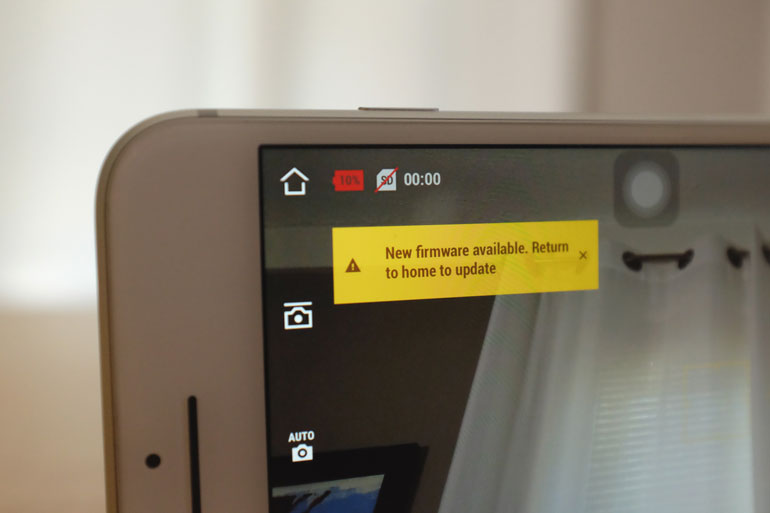
This goes for any camera or piece of gear or software or tech - if you have a job that’s currently in production, avoid any kind of firmware or software update until after the job is finished. Otherwise, you may run into an issue and you have to send the unit in for repair, and then you have to explain to your client that you were doing nonessential upgrades.
On another note, our unit arrived with Chinese as the default language. But thanks to google, we were able to find the right character in the menu that changed it to English. To be honest, this should be part of every instruction manual - how to change the language if you find the software in a language you can’t read.
DJI Osmo Pocket vs GoPro Hero
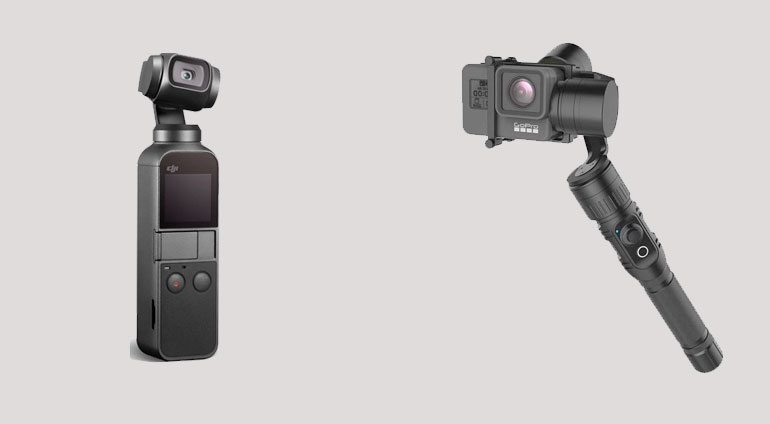
Finally, we want to say a few words about the Osmo Pocket and how it compares to a GoPro for someone who is considering one or the other.
A GoPro Hero can be abused. Inside its waterproof and durable case, a GoPro can be attached to wild, rapid-moving athletes or objects, or even animals. It can be thrown, or submerged into water. A GoPro is meant to be used in crazy environments. But while the new Hero 7 Black has a really good software-enabled hypersmooth feature, it doesn’t have a physical 3-axis gimbal.
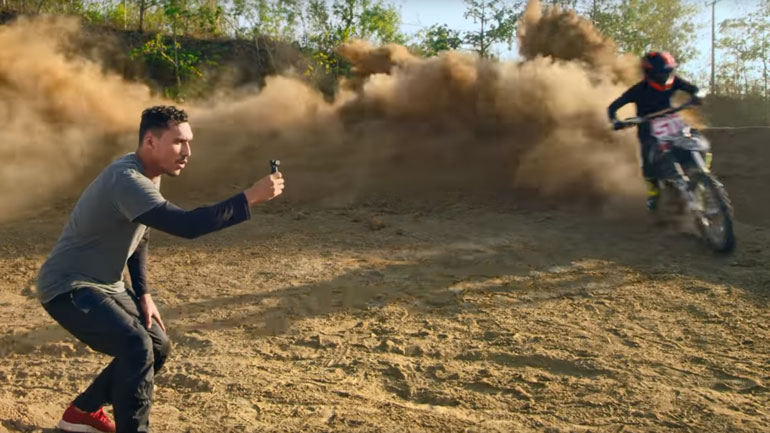
With the Osmo you'll most likely be shooting action from the sidelines, vs attaching a GoPro to the action itself
The DJI Osmo Pocket, on the other hand, is a delicate little camera on a body the size of a small candybar. If you move it too fast, the gimbal will error. If you drop it, it will probably break.
That goes for timelapses as well. You can stick a GoPro in all sorts of outdoor environments, and as long as there’s battery life, it will continue to take photos. The Osmo Pocket’s 3-axis gimbal, however, is electronically holding the camera steady with thousands of micro adjustments each second, and that electronic connection does not spell durability.
DJI Osmo Pocket Review Conclusion
We started off this review by noting how brilliant DJI is at convincing us to buy new gear and tech that doesn’t really do anything we can’t already do. Somehow in a world where there are unlimited small consumer video cameras, the DJI Osmo Pocket still finds a place in our wish lists.
For the pro or hobbyist video shooter who already has a decent camera and gimbal, the Osmo Pocket is a nice toy, but you won’t reach for it when there is a better option.
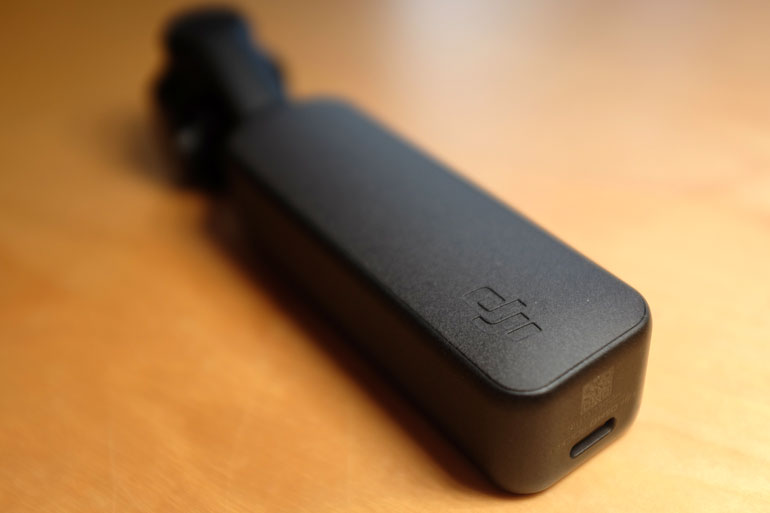
But in those situations where somebody wants to shoot a decent video, and any other camera - including a smartphone - is a little too complex, the Pocket is remarkable. It really is the easiest video camera on the planet right now, especially if you set it up in auto-everything mode.
For most of us it comes down to is image quality, however. And the Osmo Pocket does not shoot pretty pictures. It shoots stable footage, yes, maybe a little more stable than a handheld smartphone, but it doesn’t fix the typical up and down wobble for walking shots.
It may be the same camera that’s in a Mavic 2 Zoom, but the feature that makes amazing drone footage isn’t the camera, it’s the fact that a Mavic is hundreds of feet in the sky, capturing images we don’t typically see. At eye level, a Mavic camera is nothing special.
Even the official DJI Osmo Pocket marketing videos couldn't make the footage look that great. Take a look for yourself.
Years before we could put professional cameras on gimbals, we would grab a DJI Phantom and shoot with it handheld - outside a car sunroof, or while walking in an office. It was the an easy way to get stabilized footage. The Osmo Pocket is the grown up, 2018-19 version of shooting with a drone camera on ground-level.
Amazingly simple, cheap enough to bring to any production or to hand off to a newbie for good-enough footage. But don’t sell your other cameras or gimbal just yet.
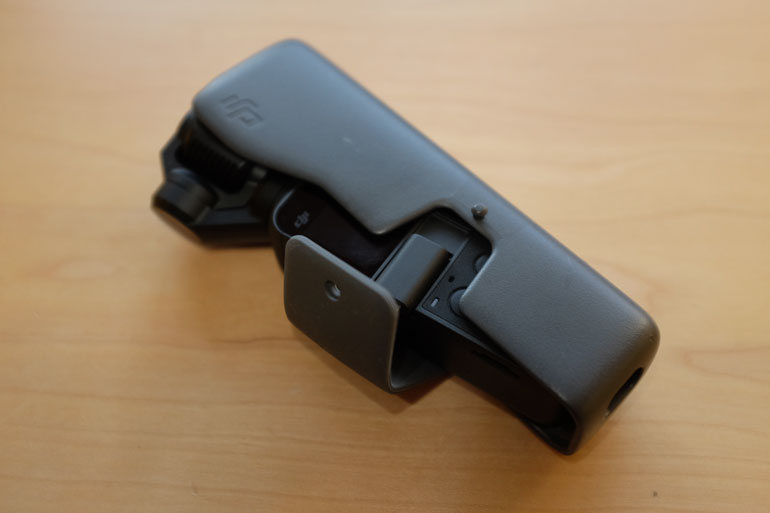
Lastly, we want to make a note of how small the Osmo Pocket is. It’s small enough to shoot discreetly in places where even a smartphone would get noticed. In our case, it’s small enough that we ended up losing it for a few days. After a thorough search with every family member’s assistance, we found the Osmo Pocket in a couch cushion.
So there you have it. The DJI Osmo Pocket is a 4k camera with a built-in 3-axis gimbal that may one day end up in a couch cushion. What an amazing time to be alive.
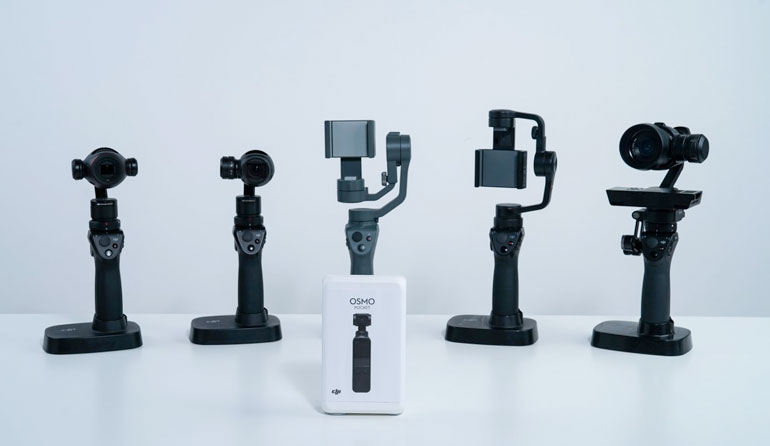
The DJI Osmo family, with the little baby in the front.
DJI Osmo Pocket Gimbal -Check price at B &H Photo
